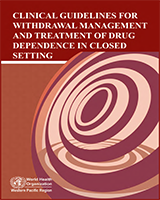Introduction
These WHO guidelines are designed to assist staff of closed settings to provide safe and effective withdrawal management and treatment services for people who use drugs in the Western Pacific Region. For the purposes of this document, “closed settings” refers to prisons, work camps, compulsory drug treatment centres and any other institution in which people are detained.
These guidelines take a public health approach to drug use and dependence. This approach recognises that the health of one individual affects the health of the community.
The WHO Western Pacific Regional Office recognizes that incarceration of people who use drugs is a reality in the region, despite the fact that it is not an appropriate solution for the use of drugs or health of people who use drugs. Therefore, the reality imposes the need for this transitional guidelines of appropriate drug treatment in anticipation of a better solution for the drug problem in the region.
These guidelines provide information about drugs and drug dependence; the management of drug withdrawal; and approaches to treatment for drug dependence. A training manual on the use of the guidelines has also been developed and will be available in the WHO Western Pacific Region website (http://www.wpro.who.int/sites/hsi/main.htm).
It is anticipated that the recommendations in this document will remain valid until 2014. The HIV/AIDS and STI Focus, Division of Combating Communicable Diseases, at WHO Western Pacific Regional Office will be responsible for initiating a review of these recommendations at that time.
The designations employed and the presentation of the material in this publication do not imply the expression of any opinion whatsoever on the part of the World Health Organization concerning the legal status of any country, territory, city or area or of its authorities, or concerning the delimitation of its frontiers or boundaries. Dotted lines on maps represent approximate border lines for which there may not yet be full agreement.
The mention of specific companies or of certain manufacturers' products does not imply that they are endorsed or recommended by the World Health Organization in preference to others of a similar nature that are not mentioned. Errors and omissions excepted, the names of proprietary products are distinguished by initial capital letters.
The World Health Organization does not warrant that the information contained in this publication is complete and correct and shall not be liable for any damages incurred as a result of its use.

